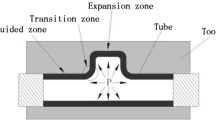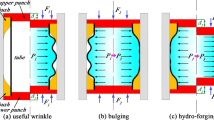Abstract
Due to the influence of pressure control precision, the actual pressure in hydroforming process for the tube is usually greater than the design pressure, which causes the fracture of tube. The loading path of T-shaped tube hydroforming process was designed based on the control of limit pressure. First, the limit pressure of tube Pmax was obtained by improving the internal pressure until the tube cracked in the T-shaped tube hydroforming process without the feeding and a theoretical model for predicting instantaneous pressure is developed. Second, the tube bulge height Hmax and the maximum feeding Dmax were explored through manual operation of feeding and pressure in hydroforming machine, in which the overflow pressure is set to Pmax by using an overflow valve; finally, the loading path of internal pressure and feeding was designed using the ladder growth and linear growth in T-shaped tube hydroforming experiment in which the maximum pressure, the maximum feeding, and the overflow pressure (equal to internal pressure) were set to Pmax, Dmax, and Pmax, respectively. The results show that the obtained limit pressure Pmax can avoid the overpressure of the tube and restrain the fracture of the tube through the action of the overflow valve. Meanwhile, the accuracy of the prediction model to figure up Pmax was verified through experiments: the theoretical prediction value of the established model was consistent with the experimental true value. Compared with the T-shaped tube formed by linear loading path, the wall thickness of the formed T-shaped tube by ladder loading path is more evenly distributed without wrinkles and fractures and the height of the formed branch tube close to Hmax. At the same time, it is found that under the differential lubrication tube blank, the time of obtaining a suitable loading path is significantly reduced, and the collocation of ladder mode is simpler and more efficient.














Similar content being viewed by others
References
Yuan SJ, Liu G (2014) 3.04 - Tube hydroforming (internal high-pressure forming). Compr Mater Process (55-80)
Bihamta R, Bui QH, Guillot M, D’Amours G, Rahem A, Fafard M (2015) Global optimisation of the production of complex aluminium tubes by the hydroforming process. CIRP J Manuf Sci Technol 9:1–11
Hwang Y, Chen Y (2017) Study of compound hydroforming of profiled tubes. Proc Eng 207:2328–2333
Ahmetoglu M, Sutter K, Li XJ, Altan T (2000) Tube hydroforming: current research, applications and need for training. J Mater Process Technol 98(2):224–231
Nikhare C, Weiss M, Hodgson PD (2009) FEA comparison of high and low pressure tube hydroforming of TRIP steel. Comput Mater Sci 47(1):146–152
Xu Y, Zhang S, Cheng M, Song H, Zhang X (2014) Application of pulsating hydroforming in manufacture of engine cradle of austenitic stainless steel. Proc Eng 81:2205–2210
Shirayori A, Fuchizawa S, Ishigure H, Narazaki M (2003) Deformation behavior of tubes with thickness deviation in circumferential direction during hydraulic free bulging. J Mater Process Technol 139(1):58–63
Ma Z, Zhang DZ, Liu F, Jiang J, Zhao M, Zhang T (2020) Lattice structures of Cu-Cr-Zr copper alloy by selective laser melting: microstructures, mechanical properties and energy absorption. Mater Des 187:108406
Alaswad A, Benyounis KY, Olabi AG (2011) Employment of finite element analysis and response surface methodology to investigate the geometrical factors in T-type bi-layered tube hydroforming. Adv Eng Softw 42(11):917–926
Liu G, Peng J, Yuan S, Teng B, Li K (2015) Analysis on critical conditions of sidewall wrinkling for hydroforming of thin-walled tee-joint. Int J Mach Tool Manu 97:42–49
Lang L, Li H, Yuan S, Danckert J, Nielsen KB (2009) Investigation into the pre-forming’s effect during multi-stages of tube hydroforming of aluminum alloy tube by using useful wrinkles. J Mater Process Technol 209(5):2553–2563
Teng B, Yuan S, Chen Z, Jin X (2012) Plastic damage of T-shape hydroforming. Trans Nonferrous Metals Soc China 22:s294–s301
Xu X, Wu K, Wu Y, Jie X, Fu C (2019) A novel lubrication method for hydroforming of thin-walled aluminum alloy T-shaped tube. Int J Adv Manuf Technol 102(5):2265–2273
Li S, Yang B, Zhang W, Lin Z (2008) Loading path prediction for tube hydroforming process using a fuzzy control strategy. Mater Des 29(6):1110–1116
Mirzaali M, Seyedkashi SMH, Liaghat GH, Moslemi Naeini H, Shojaee GK, Moon YH (2012) Application of simulated annealing method to pressure and force loading optimization in tube hydroforming process. Int J Mech Sci 55(1):78–84
Abedrabbo N, Worswick M, Mayer R, van Riemsdijk I (2009) Optimization methods for the tube hydroforming process applied to advanced high-strength steels with experimental verification. J Mater Process Technol 209(1):110–123
Fann K, Hsiao P (2003) Optimization of loading conditions for tube hydroforming. J Mater Process Technol 140(1):520–524
Ghosh A, Deshmukh K, Ngaile G (2011) Database for real-time loading path prediction for tube hydroforming using multidimensional cubic spline interpolation. J Mater Process Technol 211(1):150–166
Kim SY, Joo BD, Shin S, Van Tyne CJ, Moon YH (2013) Discrete layer hydroforming of three-layered tubes. Int J Mach Tool Manu 68:56–62
Hashemi R, Assempour A, Abad EMK (2009) Implementation of the forming limit stress diagram to obtain suitable load path in tube hydroforming considering M-K model. Mater Des 30(9):3545–3553
Chen M, Xiao X, Tong J, Guo H, Wen J (2018) Optimization of loading path in hydroforming of parallel double branched tube through response surface methodology. Adv Eng Softw 115:429–438
Imaninejad M, Subhash G, Loukus A (2005) Loading path optimization of tube hydroforming process. Int J Mach Tool Manu 45(12):1504–1514
Manabe K, Sato H, Itai K, Vilotic M, Tada K (2017) Factors influencing the forming characteristics in micro tube hydroforming by ultra high-forming pressure. Proc Eng 207:2334–2339
Lu X, Jin H (2018) Combined process of hydroforming and electro hydraulic precision reshaping for aluminium alloy. Proc Manuf 15:907–914
Xu X, Wu K, Wu Y, Fu C, Fan Y (2019) Push-bending method development of thin-walled tube with relative bending radius of 1 using sectional elastomers as mandrel. Int J Adv Manuf Technol 105:995–1008
Song W, Heo S, Ku T, Kim J, Kang B (2010) Evaluation of effect of flow stress characteristics of tubular material on forming limit in tube hydroforming process. Int J Mach Tool Manu 50(9):753–764
Jiang L, Jonas JJ, Boyle K, Martin P (2008) Deformation behavior of two Mg alloys during ring hoop tension testing. Mater Sci Eng A 492(1):68–73
Lianfa Y, Cheng G (2008) Determination of stress-strain relationship of tubular material with hydraulic bulge test. Thin-Walled Struct 46(2):147–154
Hwang Y, Lin Y, Altan T (2007) Evaluation of tubular materials by a hydraulic bulge test. Int J Mach Tool Manu 47(2):343–351
Koç M, Aue-u-lan Y, Altan T (2001) On the characteristics of tubular materials for hydroforming—experimentation and analysis. Int J Mach Tool Manu 41(5):761–772
Hwang YM, Wang CW (2009) Flow stress evaluation of zinc copper and carbon steel tubes by hydraulic bulge tests considering their anisotropy. J Mater Process Technol 209(9):4423–4428
Manabe K, Chen X, Kobayashi D, Tada K (2014) Development of in-process fuzzy control system for T-shape tube hydroforming. Proc Eng 81:2518–2523
Nakamori T, Shukuno K, Manabe K (2017) In-process controlled Y-shape tube hydroforming with high accurate built-in sensors. Proc Eng 184:43–49
Manabe K, Suetake M, Koyama H, Yang M (2006) Hydroforming process optimization of aluminum alloy tube using intelligent control technique. Int J Mach Tool Manu 46(11):1207–1211
Funding
The authors thank the financial supports from the National Natural Science Foundation of China with Grant No. 51975267 and the Key R&D Project in Jiangxi Province of China with Grant No. 20182ABC28001.
Author information
Authors and Affiliations
Corresponding author
Ethics declarations
Conflict of interest
The authors declare that they have no conflict of interest.
Additional information
Publisher’s note
Springer Nature remains neutral with regard to jurisdictional claims in published maps and institutional affiliations.
Rights and permissions
About this article
Cite this article
Wang, L., Xu, X., Fan, Y. et al. Loading path design of thin-walled aluminum alloy T-shaped tube hydroforming process based on the control of limit pressure. Int J Adv Manuf Technol 108, 3119–3131 (2020). https://doi.org/10.1007/s00170-020-05526-0
Received:
Accepted:
Published:
Issue Date:
DOI: https://doi.org/10.1007/s00170-020-05526-0




